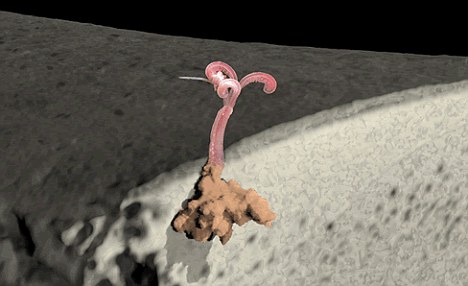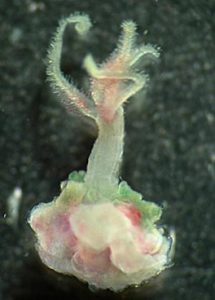Osedax worms feature in episode 2 of David Attenborough’s “Blue Planet II”. The program was shown on Channel 9 TV recently. I was able to watch it on my PC a week later. Episode 2 of Blue Planet II can be found at https://www.9now.com.au/blue-planet-ii/2018/episode-2 .
A ‘whale fall’ is shown at about 19.30 minutes in to the program. It goes on to show how bone-eating worms become established on a whale carcass. The name ‘Osedax’ wasn’t used in the program at all, only the term ‘zombie worms’.
According to Wikipedia, “Osedax is a genus of deep-sea siboglinid* polychaetes, commonly called boneworms, zombie worms, or bone-eating worms”.
* (Also according to Wikipedia, “Siboglinidae, also known as the beard worms, is a family of polychaete annelid worms whose members made up the former phyla Pogonophora (the giant tube worms) and Vestimentifera. They are composed of about 100 species of vermiform creatures and live in thin tubes buried in sediments at ocean depths from 100 to 10,000 m (300–32,800 ft). They can also be found in association with hydrothermal vents, methane seeps, with sunken plant material or whale carcasses.)
As I wrote in “Osedax Worms Update 2” at https://mlssa.org.au/2017/06/19/osedax-worms-update-2/ , “I have previously written two Newsletter articles (November 2005 http://seadragon.podzone.org/nletters/november2005.htm & January 2006 http://seadragon.podzone.org/nletters/january2006.htm ) and two Journal articles (2012 & 2013) regarding Osedax worms.”
(The two newsletter articles were parts 1 & 2 of my article titled “Greg Rouse’s Marine Worm (& Feather Star) Research”. The first Journal article, “Osedax Worms” was published in our 2012 Journal. The second Journal article, “Osedax Worms Update” was published in our 2013 Journal.)
This photograph featured in my 2012 Journal article: –
A female Osedax worm which had been carefully removed from the whale bone in which it was growing (Credit: Copyright 2009 Greg Rouse)
This worm has green, feathery palps, which extract oxygen from seawater. At its lower end are an ovisac and bulbous “roots,” which would normally be embedded in the whale bone.
“Osedax Worms Update” in our 2013 Journal was only a brief report. It is reproduced here below: –
“Osedax Worms Update
In my 2012 Journal article “Osedax Worms”, I wrote “Acid-Wielding Worms Drill Through Bones at the Bottom of the Sea – Tiny ‘bone-devouring worms’, known to both eat and inhabit dead whale skeletons and other bones on the sea floor, have a unique ability to release bone-melting acid, scientists at Scripps Institution of Oceanography, University of California, San Diego have recently discovered. The work (was) being presented at the Society for Experimental Biology’s 2012 meeting in Salzburg, Austria (from the 29th of June to the 2nd of July 2012).”
Towards the end of my article, I wrote “(Greg) told me that there hadn’t been any work published from the presentation at Salzburg to date, but that it should be out late 2012” and “I have . . . asked Greg to let us know when the work from the presentation at Salzburg has been published.”
The work had still not been published by May 2013. Another article, however, was published that month (May 2013). The article titled “How to get into bones: proton pump and carbonic anhydrase in Osedax boneworms”1 by Martin Tresguerres, Sigrid Katz and Greg W. Rouse was published in the May 2013 “Proceedings of the Royal Society”. The article can be downloaded from www.rspb.royalsocietypublishing.org . There are several photos and diagrams in the article.
1. Tresguerres, M., Katz, S. & Rouse, G.W. 2013. How to get into bones: proton pump and carbonic anhydrase in Osedax boneworms. Proceedings: Biological Sciences 280: 20130625–20130625.”
(The header photo shows a computer-generated reconstruction of the Osedax worm – courtesy of the University of Leeds)
(See “What happens after a whale dies?” at https://www.npr.org/2019/09/13/760664122/what-happens-after-a-whale-dies )


